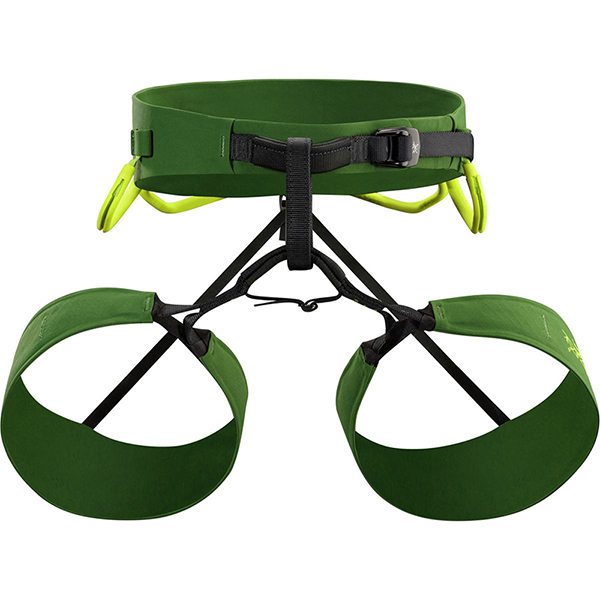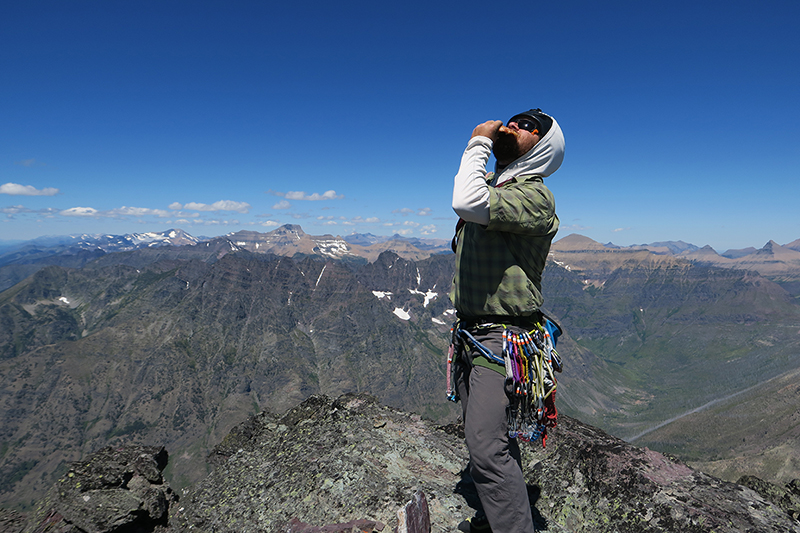
Arc’teryx Men’s FL-365 Harness
Stated Weight: 365 g / 12.9 oz
Sizes: XS-XL
Size tested: Large
Reviewer Info: 5’8”, 190 lbs; Waist: 34-35”; Quad circumference: 22.5”
Color: Stone Pine (only color available)
Leg Loops: Fixed/elasticized.
Stated Features:
- Wear safety markers in belay loop and hard points
- Auto-locking, smoothly releasing waist buckle
- Warp Strength Technology (WST) spreads load throughout the wider leg and waist bands
- Fixed, elasticized leg loops
- Four floro-epic gear loops/extra wide haul loop
- Four slots for ice clippers
- Stretch mesh storage bag
- High functioning dropseat
MSRP: $145
Test Locations: Mt. Erie, WA; Stone Hill, Point of Rocks, Stillwater Canyon, Kila Crags, Blodgett Canyon Bridger Range, Gallatin Canyon, Glacier National Park, MT
Days Tested: 28
Intro
The truth about most climbing harnesses is sort of anticlimactic: they’re just webbing. Conveniences like gear loops and buckles and dedicated hard points are certainly nice, but most of the things that happen past making sure that the webbing can hold you in a fall are done in the name of comfort. Compare climbing harnesses to say, a ski binding, and it’s fair to say that the level of technical design is a bit, um, lower.
This basis in simple webbing hasn’t stopped companies that make climbing harnesses from avoiding webbing in the name of doing interesting and expensive things toward the cause of comfort and looking cool. Black Diamond and Petzl offer several harnesses that make use of alternative constructions in the waist and leg loops. However, Arc’teryx has been working the more-than-webbing corner of the market for quite a while, and far longer than either BD or Petzl.

I’ve owned webbing-based harnesses that didn’t cost much for all of my climbing life. So when it came time to replace my harness this season, I picked up the Black Diamond Solution, figuring that I’d use it for sport and gym pursuits. For the outside climbing I was doing, I needed something with better racking options, and saw the opportunity to test the split-webbing construction of the Solution against a non-webbing construction.
Enter the Arc’teryx FL-365. Really, the 365 in the name says it all — this thing is meant for the climber who wants to carry gear year round. It offers a good comparison to my Solution and the webbing harnesses I’d used before (primarily the Edelrid Jay). So while this is mostly a review of the FL-365, being used for guiding and gear intensive climbing outside, I’ll comment on those comparisons where appropriate.
Fit
Fitting a harness to your body is really important. I’ve purchased a couple of harnesses online, and the fit has been far worse than those I’ve spent time in by borrowing a friend’s or a store before picking them up. It goes without saying that big wall, alpine or multi-pitch climbing will see you spending more time hanging in your harness than if you’re just cranking single pitch sport routes, so fit is even more crucial.
Most of the higher-end harnesses on the market use a buckle on one side of the harness to tighten the waist band. Fit can suffer if you don’t exist in the right part of the spectrum for that particular harness, as can the placement of the hard points and gear loops.
I check in at 34-35” at the waist right now for most clothing brands. The FL-365 in size Large has about 3.75” of webbing left to run through the buckle when I snug the waistband down. Hard points sit directly in front. The gear loops are equally placed along my sides, which means I can reach across my body to grab gear off the opposite side while placing a piece.

That’s a stark contrast to my Black Diamond Solution. The size chart suggests that I’m right on the money at 34” for a Large, but the harness itself doesn’t fit that way. A 6” gap of webbing with no foam backing sits between the harness sections when I tension it down. Gear loops are positioned too far counterclockwise to be well seen on my left (9” left of the belay loop), and far enough forward on my right to snag and get in the way while climbing (4.5” from the belay loop). An XL might have solved these problems, but the size chart discrepancy remains.
Rise, in climbing harnesses, refers to the length of the distance between the waistband and leg loops. A few measurements come together to make the rise on a given harness: length of the leg loops, the amount of webbing between them, and the diameter of the belay loop. On the FL-365, the rise seems a hair on the short end for me, with a 9” circumference belay loop. This gets worse when the rope or a personal anchor pulls the hard points together under tension. Such shortening can be mildly uncomfortable for moving around. My Solution doesn’t have this minor issue.
Comparing the Arc’teryx and Black Diamond charts suggests that Arc’teryx has slightly larger range per size, and seems to fit truer to what I’ve worn through most brands’ Mens’ Larges.
Comfort
On long days of single pitch guiding or the alpine objectives we hit this summer, the FL-365 was the most comfortable harness I’ve yet used or worn. There’s a lot to be said for the way the wide bands of the harness use absolutely no padding to keep things comfy; I even spent six hours hanging in the harness over the course of a day of scrubbing to really test it out. Similar time in my Solution or Jay left me with numb, painful legs. So if you were wondering—yes, the wide bands really do work to keep you happy in the saddle.
Falling in the FL-365 is similarly a nice experience. No pressure points developed when I peeled off a variety of harder pitches, and I took a couple larger falls in that process.
Breathability
Inevitably, the way that the wide bands distribute weight also makes things potentially sweatier under the harness. I’m somewhat broad of beam to begin with; any harness is going to cause some sweat. The FL-365 didn’t cause anything out of the ordinary in that department for me, and the comfort achieved with the wide bands is worth the tradeoff.
NEXT: Features, Gear Loops, Etc.
